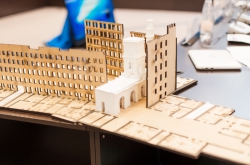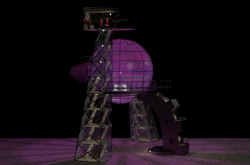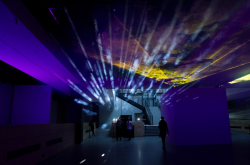About Caty Olive
Caty Olive graduated from the École Nationale Supérieure des Arts Décoratifs of Paris; she creates lighting designs for architectural projects, presents her own lighting installations at festivals and exhibitions, and designs stage lighting for plays. Ms. Olive has collaborated with many theatres and performers in France and around the world.
“I have always been interested in working not with static elements, but with something that is always in motion. Intuitively, I chose light as my main field of work. I enjoy creating uncertainty in spaces; light is, by its nature, uncertain. The understanding of the light’s functions has changed gradually, depending on the ways in which it was used,” – says Olive.
Light and religion

Tutankhamun's golden facemask
The golden facemasks of the pharaohs of Ancient Egypt emphasized the divine nature of the faces they depicted. That is an example in which light has a religious significance, explains the artist. The pharaohs’ divine powers were expressed through light. As Christianity emerged, bright golden paint was used to accentuate not the faces, but, inversely, their surroundings; this, too, has a religious intent: a shadowed face, a shining halo, a golden frame – all this signified the holiness of a person. Byzantine paintings of Jesus Christ used light differently, using it to add brightness to the face, also to indicate the subject’s divine origin. However, in all of these cases, the light itself had no “role” of its own.
Renaissance: light and shape

"The Last Supper"
During the Renasissance, Leonardo da Vinci was the first to study the optical properties of light from the points of view of visual sense, science and art. He observed the specifics and patterns of human perception of light using knowledge of physics, biology, anatomy and other sciences. This was a crucial step forward: the great scientist was the first to understand that a person’s perception of space depends greatly on light. He applied his studies in art and used light to create perspectives and shapes in his paintings. His most famous example of use of perspective is “The Last Supper”.

"The Dream of St. Joseph"
Caty Olive brought up another notable example of how late-Renaissance artists employed light and shadow in their work – the paintings of Georges de La Tour. In his work, La Tour used light to masterfully create scenes in which there are only a few light sources – single candle, for instance. In the painting “The Dream of St. Joseph”, the candle is obscured by a girl and only her face and palm are illuminated by its light; at the same time, a dimmer light is cast on the old man, which creates a sense of volume an perspective in the painting, telling the observer exactly where the characters are located.
Age of Enlightenment: light as subject

"Woman with a Pearl Necklace"
In the 17th century, lighting becomes more than a tool for creating shape; it plays its own role in the works of great artists. The Dutch master of domestic painting, Jan Vermeer, used light sources not only to create volume, but to make light a part of the painting. In his “Woman with a Pearl Necklace”, most of the painting is taken up by a white wall reflecting the light from a window. Thus, light becomes an identifiable character of the painting.
“This concept became even more ingrained in artists’ thoughts after Isaac Newton wrote about the nature of light as a constant emission that can be split into countless spectres, and how there is no color, only the people’s perception of it,” – notes Olive.
In the 18th century, this is also confirmed by chemists. Per the request of textile makers and painters, they study the ways of making colors and paints brighter, but come to the conclusion that their brightness depends not on the color itself, but how it is perceived and with which colors it is combined.
Claude Monet’s light

One of the 250 paintings in Monet's series "Water Lilies"
One of the first to truly make light a central character was Claude Money. In some of his works, it is near impossible to discern an object or a shape unless you examine it carefully and with consideration. One of the shining examples of such work is Monet’s series “Water Lilies”, on which he worked for three decades. The paintings depict water surfaces that reflect the various elements of nature: clouds, the setting sun, leaves and forests. In each of the images, it is the light that forms it, not the objects themselves.
Futurists: motion and music
“With the appearance of electricity, futurists adopted the idea of light becoming a subject of an image and being associated with speed, movement, energy, music,” – explains Caty Olive.

Luigi Russolo's "Music"
The beginning of the 20th century brought changes to all forms of art. The emergence of the photographic camera and recording devices turned the art world upside down. Futurists saw this new world – and the meaning of light in it – in a special way. Music and art were combined in the works of such artists as Luigi Russolo. In 1911, he created “Music”; the painting depicts a piano player, and the sounds of music are shown as vivid and twisting ribbons of color. Even back then, artists and musicians had understood how difficult it is to design stage lighting to enhance the performers’ appearance.
Loie Fuller – a pioneer of stage lighting
As a trailblazer of dancing, Loie Fuller did not only elevate her art to a new level, but also began a new chapter in the history of theater – one on the use of light as a stage character – that has yet to close. She experimented with lighting and nearly literally bathed in the lights of projectors, which were a crucial part of what made her performances so captivating.
“Her most well-known dance is “Serpentine”, for which Fuller paid a great deal of attention to light and how it can be manipulated. She tried to relay to the viewers that a body on stage may have other functions; that the intricate game of light and shadow can be just as important as the beauty of the dancer,” – says Olive.
20th century and light as art
The appearance of the term “light art” can be connected to the world’s first piece of art in which a physical object was combined with light and used to show the relationship between light and object – “Light-Space Modulator” by the Hungarian artist László Moholy-Nagy. The sculpture is made up of metal objects fixed to a spinning metal stand and illuminated by small colorful lights. The artist’s intention was to show the movement of light itself.
Another Hungarian, Nicolas Schöffer, had gained worldwide attention after a 50 meter metal tower of his design was constructed in Paris in 1954. The tower was equipped with projectors shining in all directions, serving as a symbol of the union of different technologies, of dynamism, of energy.
All of those laid the groundwork for today’s light kinetic art. This modern form of art combines light with sculpture, architecture, urban environments and living objects to create illusions and express the authors’ artistic concepts. These light installations can also be combined with sound or other supplementary materials. For example, in one of her works Caty Olive uses an oscillating string of light, the movements of which are combined with corresponding sounds.
Light, thus, has come a long way from being a background element in paintings to being its own form of art. Today, light installations and lighting design play an increasingly bigger role not only among artists and exhibitions, but in urban lighting, in creating urban spaces and decorating indoor spaces. Besides that, it is also becoming a means of communication and expression, similar to music, cinema and other forms of art.





